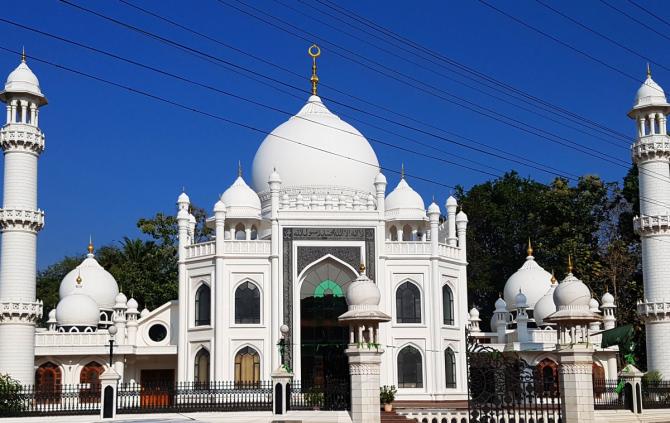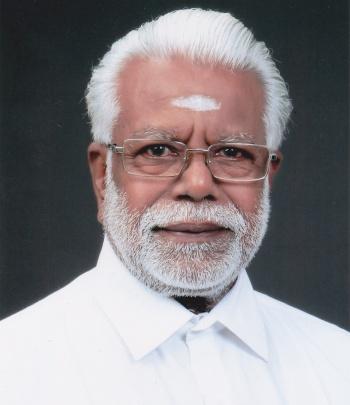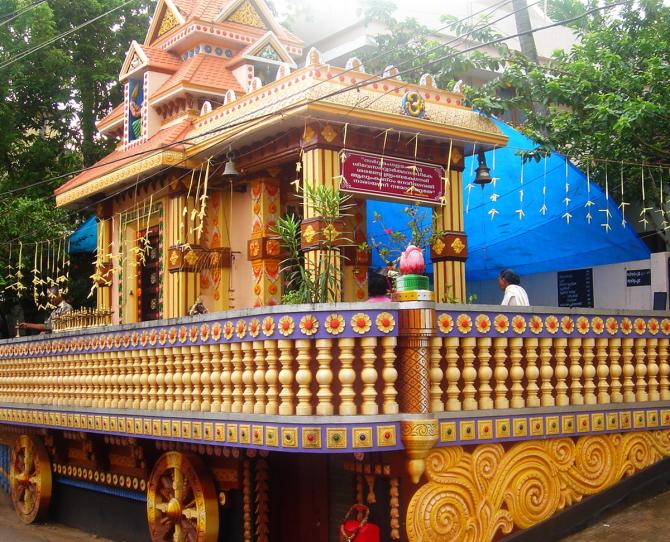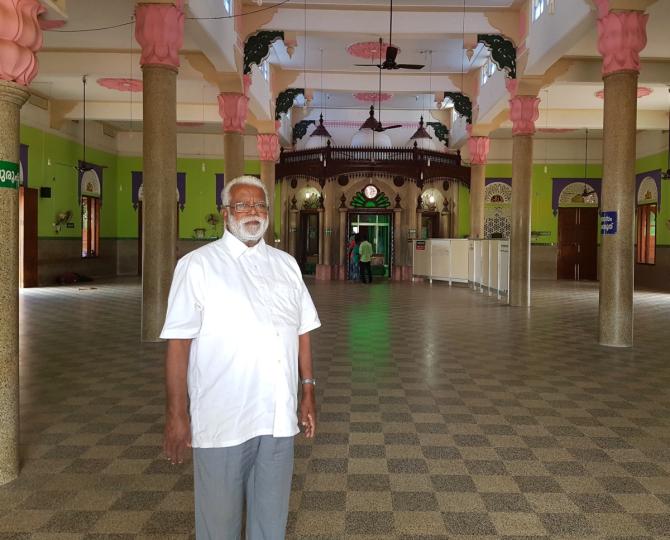'...that has plants and flowers of all colours and hues in it.'
'Do you think a garden with just one plant or one type of flower will be appealing?'
'No. It will look drab, uninteresting and lustreless because a garden would be captivating only if it had many flowers of different colours.'

In these turbulent times, nothing is more newsworthy than the story of a Hindu man building a mosque with money coming from a Christian. But this story happened not now,but almost six decades ago! In Kerala.
In 1962, when G Gopalakrishnan achieved this rare feat, nobody found it worth writing about or talking about it.
Today, 85-year-old Gopalakrishnan is looked upon as a symbol of universal brotherhood and religious harmony, and he is enjoying the attention he is getting in his twilight years.
In his career as a 'self-taught' architect and a builder, he went on to construct 111 mosques, 4 churches and a temple.
Gopalakrishnan shares milestones in his incomparable journey with Rediff.com's Shobha Warrier.

IMAGE: G Gopalakrishnan
Getting a chance to build a mosque
I am a self-taught architect. Because my father, K Govindan Contractor, was a builder and a designer, I learnt the art of designing mostly from his sketches and clearing my doubts from the person who designed for him.
The first and the most memorable experience I had was building the Palayam Juma Masjid.
As you know, the Palayam junction in Thiruvananthapuram is famous all over the world for having a church, a mosque and a temple close to each other.
The year was 1962.
When P P Kuttiamu Sahib, the first chief engineer of the PWD department in Kerala, noticed that this mosque was in a very pathetic condition, he formed a committee to reconstruct it.
He showed the picture of the façade of the Safdarjung mausoleum in Delhi to the then chief architect J C Alexander.
Though the mausoleum did not have a minar, Kuttiamu Sahib wanted a minar in the structure.
The mosque committee called for a tender, and what my father quoted was the lowest.
Though we won the tender, we didn't have enough money to start work.
It was exactly at the same time that I had got a contract to build a house for P C Chummar who worked at the accountant general's office.
He had given me a cheque for Rs 5,000 as advance to start the foundation work.

My father felt we should do both the house and the mosque simultaneously, and use the advance given by Chummar for building the mosque.
I opposed it saying we couldn't use Chummar's money for any other purpose. Then my mother intervened and asked me to get Chummar's opinion on this.
When I narrated the situation we were in, he said, 'Why not? You can use it for the mosque. Anyway, it will take some time for me to get the loan from my office.'
That was how the fund to rebuild the mosque came from him, a Christian. And we were Hindus involved in building the mosque. And the architect was J C Alexander, a Christian.
When I realised this coincidence, I started believing in the idea of universal brotherhood.
Of course, nobody wrote about this aspect then. Perhaps it was not that significant in those days.
We started work in 1962, and this landmark mosque was inaugurated by the then President of India, Dr Zakir Hussain in 1967.

It was the first mosque with a Minar in Kerala.
Following the traditional Kerala architecture, all the mosques and churches in Kerala had slopping tiled roofs, just like the temples.
It was after reconstruction of the Palayam Juma Masjid that the mosques in Kerala moved towards the Indo-Saracenic style with minars in place of a slopping tiled roof.
After we rebuilt the Palayam mosque, so many people contacted Kuttiamu Sahib to change the style of the existing mosques to Indo-Saracenic style.
Because I was involved in the Palayam Juma Masjid, he made me design and rebuild many mosques after that.

In 1966, even before the inauguration of Palayam Juma Masjid, I got a chance to independently design a mosque.
It is the now famous Beemapally Masjid.
Till then, I had designed many mosques at many places, but all of them wanted me to design on the lines of the Palayam Juma Masjid.
What made Beemapally Masjid different was the presence of two shrines or khabar of two saints inside, and the old mosque had a tiled roof.
After seeing the Palayam Juma Masjid, they approached Kuttiamu Sahib to reconstruct this one too with a minar at the top. He asked architect Rahim Sahib to design the new mosque.
The problem with the sketch drawn by Rahim Sahib was, the shrines would be in one corner of the hall when they should have been at the centre.
When I pointed this out to him, he asked me to draw.
I have no words to say how excited I was when he said so.
I couldn't believe that I was getting a chance to independently design a mosque when I didn't have a degree in architecture, when I didn't have any qualification to do so except that I had built quite a few mosques!
So excited was I that I worked day and night without any rest or sleep for a week.

In those days, we didn't have electricity in our house. So, at night I would have a lantern to continue working.
We were very poor, but we made sure that whatever work we did, we did with utmost sincerity and dedication.
Our father had taught us that work was more important than making money.
When we knew how the committee members went around collecting small amounts of money, the thought of making money did not come to our mind also.
Though I started building the Beemapally Masjid in 1967, we could finish it only in 1984! You can say I dedicated 17 years of my life, my youth, in building this mosque.
Of course, I was doing other work for Kuttiamu Sahib along with this, and he paid me Rs 400 a month.
Once the Beemapally masjid was ready for inauguration, the unanimous verdict was that it was the best mosque in Kerala! I was thrilled beyond words.
The Indian touch in the Indo-Saracenic style is the lotus on which the domes of the mosques rested!
Lotus under the domes was accepted till the Babri Masjid demolition.
After that, I have been asked by people not to have any lotus in the structure.
I had always felt that the presence of a lotus in the Persian designs showed how heartily we had accepted the Persian architectural style when it made its appearance in India.
Anyway, from 1992 onwards, the lotus disappeared from all the Kerala mosques.
Building the Vavaru Juma Masjid at Erumeli in Sabarimala was an unforgettable experience because it symbolised what I believe in; universal brotherhood and religious harmony.
As you know, Lord Ayyappa devotees have no religion and all of them pray at the Vavaru pally before embarking on to Sabarimala.
I consider it my good fortune to build a religious place like Vavaru pally.
I feel extremely fortunate to have built this mosque in Karunagapally in Kollam district which has come to be known as the Taj Mahal of Kerala.
Kuttiamu Sahib had this dream to build a structure that looked exactly like the Taj Mahal in Kerala, but he couldn't realise his dream when he was alive. So, this mosque is my tribute to Kuttiamu Sahib.

When so many of my friends asked me, 'Gopalakrishna, why is it that you build only mosques? Why don't you build a church?', it kindled a desire in my mind. I wanted to build a church too.
It so happened that one day, a priest along with two others visited my office.
The priest said, 'We know you have only been building mosques, but we want you to build a church. It should look like a church and not like a mosque! Even if it looks like a temple, it is okay with us, but it should not look like a mosque!'
I told him, 'When I design a mosque, it will look like a mosque. When I am designing a church, it will be a church and it will follow the Gothic style!'
Then I asked them why they came in search of me, someone who had been building only mosques! They said, a retired chief engineer called K C Alexander suggested my name.
So, I went to see the site at Chandanapally in Pathanamthitta district along with him, and it looked heavenly, the perfect setting for a religious place.
When the church was inaugurated in 2000, I was fulfilling a wish of mine, and also answer the questions of my friends.
I went on to build three more churches.
Now, what was left was a temple. Though I am a Hindu, I got a chance to build only one temple.
It is the one next to our house which is more like our family temple. I designed it like a chariot.

Till 1992, not many knew that I, a Hindu had been building many mosques in Kerala.
But in 1992 after the demolition of Babri Masjid, The Indian Express wrote about me under the title, 'Builder of an emotional bridge'.
I am a creative person, and I believe only in creations.
I abhor destruction, destruction of any sort. Not only in India, I don't like anyone destroying any creation anywhere in the world. So, the destruction of the Babri Masjid saddened me.
More than the religious aspect, what affected me was the destruction of creation.
After studying the texts of all religions, I believe that there is an unwritten agreement between God and man.
As per the agreement, man is supposed to only improve the beauty of the earth created by God and not destroy it.
But what you see today is the abuse of nature, the abuse of the planet itself. And we are suffering the after-effects of our destructive deeds, in the form of floods, wildfires, drought and even the coronavirus.
Nature is teaching the man a lesson for breaking the agreement.
To me, India is like a garden that has plants and flowers of all colours and hues in it.
Do you think a garden with just one plant or one type of flower will be appealing? No. It will look drab, uninteresting and lustreless because a garden would be captivating only if it had many flowers of different colours.
Feature Presentation: Rajesh Alva/Rediff.com










